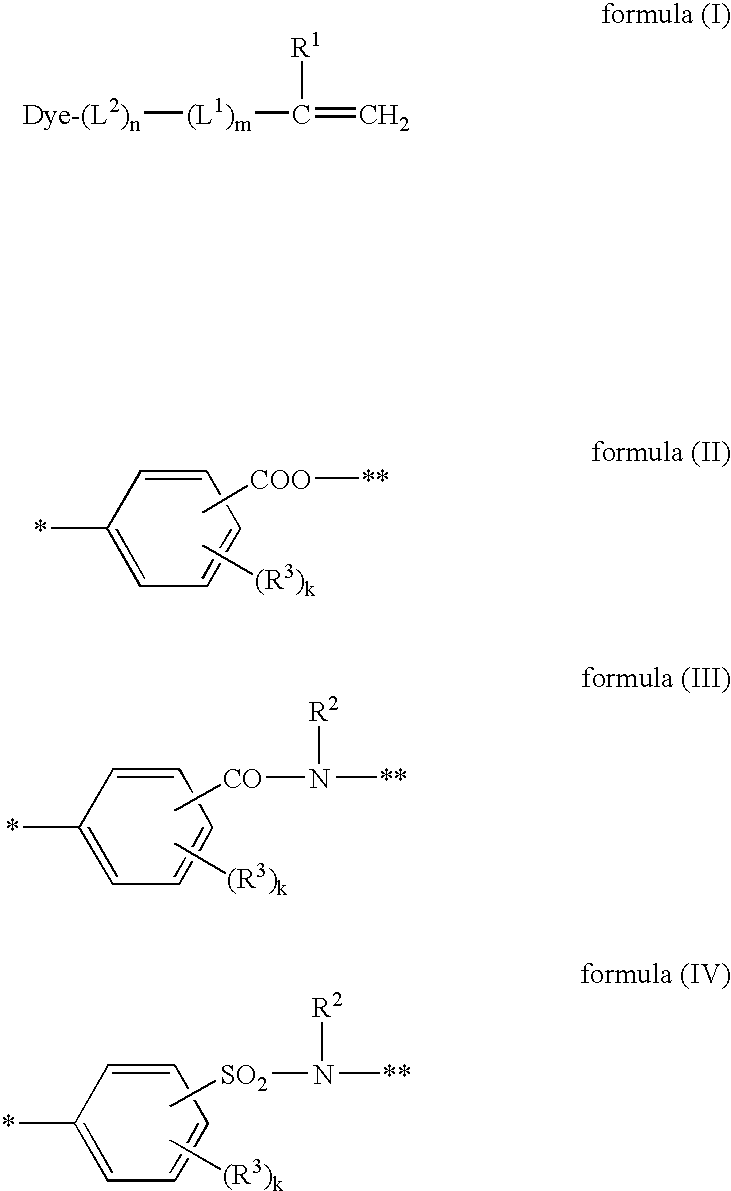Colored curable composition, color filter and method of producing thereof
a color filter and composition technology, applied in the direction of photosensitive materials, instruments, photomechanical equipment, etc., can solve the problems of insufficient tolerance to organic solvents, difficult to enhance the resolution further, and inability to precipitate out, etc., to achieve excellent thermal resistance and light resistance, and excellent stability over time
- Summary
- Abstract
- Description
- Claims
- Application Information
AI Technical Summary
Benefits of technology
Problems solved by technology
Method used
Image
Examples
example 1
[0205] (1) Synthesis of Dye Polymer
[0206] Dye polymer AP-1 was synthesized according to the following reaction scheme.
(Synthesis of Compound B)
[0207] To 134 g (0.5 mol) of compound A, 1000 ml of acetonitrile was added, and cooled to 0° C. and stirred. In this solution, 53.5 g (0.6 mol) of 2-amino-2-methyl propanol was dropped. Further, in this solution, 60.7 g (0.6 mol) of triethylamine was dropped. The solution temperature was kept at 10° C. or lower. After dropping, the solution was stirred for 1 hour. After termination of reaction, the reaction solution was stirred and poured in 1500 ml of water, and crystals were deposited. The crystals were filtered, washed in water, and dried. As a result, 117.6 g of compound B was obtained (yield: 73.6%).
(Synthesis of Compound C)
[0208] To 32.0 g (0.1 mol) of compound B thus obtained, 100 ml of N-methyl pyrrolidone was added, and stirred at room temperature. In this solution, 30.0 g (0.15 mol) of sodium benzene sulfinate dihydrate was ...
examples 2 to 24
[0255] In “(4) Preparation of dye resist solution R-1” in example 1, the same manner as in example 1 was carried out, except that exemplary dye polymer AP-1 was replaced by the equivalent mass of exemplary dye polymers shown in Table 1. Results are shown in Table 1.
example 25
[0259] (7) Preparation of Resist Solution for Undercoat Layer
[0260] The following components were mixed and dissolved, and a resist solution for undercoat layer was prepared.
[0261] Propylene glycol monomethyl ether acetate (POMEA): 19.20 parts
[0262] Ethyl lactate: 36.67 parts
[0263] Binder (41% PGMEA solution of benzyl methacrylate / methacrylic acid / methacrylic acid-2-hydroxyethyl copolymer, molar ratio=60:20:20): 30.51 parts
[0264] Dipentaerythritol hexacrylate (photopolymerizable compound): 12.20 parts
[0265] Polymerization inhibitor (p-methoxy phenol): 0.0061 parts
[0266] Fluorine-based surfactant (F-475, manufactured by DAINIPPON INK AND CHEMICALS, INC.): 0.80 parts
[0267] Photopolymerization initiator (TAZ-107, trihalomethyl triazine-based photopolymerization initiator, manufactured by Midori kagaku Co., Ltd.): 0.586 parts
[0268] (8) Preparation of Glass Support with Undercoat Layer
[0269] Glass support (Corning 1737) was ultrasonically cleaned in 1% NaOH water. It was then w...
PUM
| Property | Measurement | Unit |
|---|---|---|
| Volume | aaaaa | aaaaa |
| Volume | aaaaa | aaaaa |
| Fraction | aaaaa | aaaaa |
Abstract
Description
Claims
Application Information
 Login to View More
Login to View More - R&D
- Intellectual Property
- Life Sciences
- Materials
- Tech Scout
- Unparalleled Data Quality
- Higher Quality Content
- 60% Fewer Hallucinations
Browse by: Latest US Patents, China's latest patents, Technical Efficacy Thesaurus, Application Domain, Technology Topic, Popular Technical Reports.
© 2025 PatSnap. All rights reserved.Legal|Privacy policy|Modern Slavery Act Transparency Statement|Sitemap|About US| Contact US: help@patsnap.com



